From the Aesthetic Ontology of Modern Art in Oteiza to Postmodern Dissolution
Revisions Based on a Documentary Interview with the Basque Artist
DOI:
https://doi.org/10.18861/ania.2025.15.1.4045Keywords:
Modernism, postmodernism, modern art, Aesthetic being, construction of the void, formal gesturesAbstract
The manuscript aims to analyze, based on the reflection of an interview given by the prominent Spanish sculptor of the 20th century, Jorge Oteiza in the context of the Venice Biennale in 1988. It will be stated that synthesized in these works of art They are: Modernity and Postmodernity. In this interview, the disagreement that Oteiza experiences around the so-called post-modern art will be shown, reflected in exhibitors at the same biennial, such as arte povera or the work of Mario Mertz.
But what are the basic characteristics of the contrasting works that make us think of those times? Is Oteiza's exasperation the expression of the inevitable? And what makes such change inevitable?
In the ethos of each historical period, art also reflects the immanence of the city project. A modern city reads like a work by Oteiza. The large and widespread contemporary cities are read as works of “Poor Art”, especially in some works by Mario Mertz, which Oteiza himself is in charge of criticizing, accusing him of wanting to lull man to sleep, instead of building him or awakening him, as they sought. the formalist-constructivist avant-garde of modern art, or, exploring its unconscious contents, seeking a new horizon from which to awaken it from its state of latency.
In our extended urbanized reality of the central zone of Chile, the modern city has been blurred and appears, just as in “Poor Art”, fragmented groupings of waste among which man himself is one of them.
Downloads
References
Barbieri, G. (1999). “Pinto lo que soy”. La aventura de Congdon entre dimensión rativa y dimensión creatural. En: Varios autores. William Congdon. 1912-1998. La mirada de un testigo del siglo XX. Encuentro, Madrid.
Barcelo, M. (2002). El taller de esculturas. Tf Editores. Madrid.
Barcelo, M. (s.f.). Gaudí y Barceló en la Seu. En: Revista digital Amaia. Disponible en: https://historia-arte.com/obras/cupula-de-la-sala-xx-de-los-derechos-humanos-de-la-onu
Bogazan, F. (2012). Matta: Morfologías psicológicas y el tiempo de formación con Gordon Onslow Ford. En: Matta. Centenario. 11.11.11. Ed. Centro Cultural La Moneda. Santiago, Chile.
Cañete, O. & Moraga, J. (2021). Parresia y metrópolis: entre la razón pragmático- normativa y los modelos timóticos de convivencia actual. Revista Aletheia. Vol. 13, N.º 2. Julio-diciembre 2021; 15-38. https://doi.org/10.11600/ale.v13i2.625
(2022). Iluminaciones profanas. Ciclos del habitar en la ciudad en Walter Benjamin. Módulo Arquitectura - CUC, 28(1), 255–278. https://doi.org/10.17981/mod.arq.cuc.28.1.2022.08
(2025, en prensa). La ciudad en fuga: Imaginarios de la vida en la urbe moderna. En: Res Pública: Revista de Historia de las Ideas Políticas. En: https://revistas.ucm.es/index.php/RPUB
Castro Flórez, F. (2023). La verdadera intempestividad trágica de Anselm Kiefer. Recuperado en: https://arsmagazine.com/wp-content/uploads/2023/07/48_ARS-24_Expo- contemporanea_Kiefer3.pdf
Correia, A., & Morgan, L. (2015, 1 marzo). Helmet Head No.1 1950, cast 1960 by Henry Moore OM, CH. https://www.tate.org.uk/art/research-publications/henry-moore/henry- moore-om-ch-helmet-head-no1-r1149255
Dalí, Salvador. (1989). El mito trágico del ángelus de Millet. Tusquets. Barcelona.
Dalí, S. (1994, Ed.) ¿Por qué se ataca a La Gioconda? Siruela. Madrid.
DI Maria Acciaro. (2018). Perché l’arte povera è stata il movimento artistico più sovversivo della storia italiana. En revista digital: THEVISIÓN; 31 Dicembre 2018
Fischer, M. (2017). Realismo Capitalista Ed. Caja Negra. Buenos Aires.
Gambús Saiz, M. (2007). Miquel Barceló y la reforma de la capilla del Santísimo: Una intervención contemporánea en la Catedral de Mallorca. Actas De Arquitectura Religiosa Contemporánea, 1, 218–231. https://doi.org/10.17979/aarc.2007.1.0.5025
González, J. (2015). Anselm Kieffer y la pintura metérica. Revista digital Tamayo. 1 de diciembre de 2015. Recuperada en: https://www.ttamayo.com/2015/12/anselm-kiefer-2/
Kandinsky, W. (2006). Acerca de Lo espiritual en el arte. Libertador, Buenos Aires.
Lahuera, J. (2004). El fenómeno del éxtasis. Dali ca. 1933. Siruela. Madrid.
Marchan Fiz, S. (2008). La metáfora del cristal en las artes y arquitectura. Siruela. Madrid.
Lloyd-Smith, H. (2022). Largest collection of Mario Merz igloos pop up in Milan. En Revista digital WALLPAPER. Recuperado en: https://www.wallpaper.com/art/mario- merz-igloos-exhibition-pirelli-hangerbicocca
Oyarzun, P. (2000). Anestética del ready-made. LOM editores. Santiago.
Piñon, H. (2006). Teoría del proyecto. ETSAB, Barcelona.
Priego, M. (s.f.) Miquel Barceló. El arte como diálogo en las Naciones Unidas. Recuperado en: https://apintoresyescultores.es/tag/miquel-barcelo/
Ramírez, Juan Antonio. 1993. Duchamp. El amor y la muerte, incluso. Siruela. Madrid, España
Ramírez, Y. (2002). Elementos de iconografía e idea de arte. Tesis para obtener maestria en arte. UNAM Méxco. Recuperado en: https://ru.dgb.unam.mx/bitstream/20.500.14330/TES01000309990/3/0309990.pdf
Read, H. (1971). Imagen e idea. FCE. Maxico
Rosenthal, M. (1987). Anselm Kiefer. Publisher Art Institute of Chicago; Philadelphia Museum of Art Moderno MOMA and the U.S. and Canada by the Neues Pub. Co. Recuperado en: Exhibition URL www.moma.org/calendar/exhibitions/2143
Sawin, M. (2012). Matta en Nueva York. En: Matta. Centenario. 11.11.11. Ed. Centro Cultural La Moneda. Santiago, Chile
Suazo, Felix. (2024). Duchamp y la Odisea: 100 años de “El Gran Vidrio”. En Revista de arte digital Trafico Visual. Recuperado en: https://traficovisual.com/2023/04/03/duchamp-y-la- odisea-100-anos-de-el-gran-vidrio/
Enlaces videos online:
Jorge Oteiza en la Bienal de Venecia, 1988. Disponible en: https://www.youtube.com/watch?v=xtMWxIW0n5M
Oteiza / Arantzazu. Disponible en: https://www.youtube.com/watch?v=BpoyT7NteZE
Entrevista a Jorge Oteiza. El ser estético. Disponible en: https://www.youtube.com/watch?v=M_4ABxaQNn4
VISITA a la exposición Oteiza y Chillida. Disponible en: https://www.youtube.com/watch?v=zV9frl4q3qs

Published
How to Cite
Issue
Section
License
Copyright (c) 2025 Juan Luis Moraga Lacoste, Omar Cañete Islas

This work is licensed under a Creative Commons Attribution 4.0 International License.
The journal and its contents are licensed under the Creative Commons - Attribution 4.0 International License (CC BY 4.0). It is possible to copy, communicate and publicly distribute its content as long as the individual authors and the name of this publication are cited, as well as the publishing institution (Universidad ORT Uruguay).

